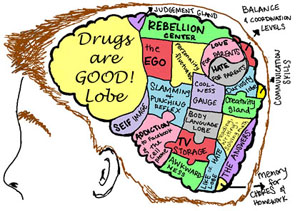Vol. 13, Issue No. 10: December 2014 – EXECUTIVE SUMMARY Are Drug.com Websites “Fair and Balanced?” FDA Studies Online DTC Prescription Drug Promotion According to Internet analytics provider comScore, patients who visit a drug brand’s website are more likely to end up taking that drug than those who don’t. FDA is aware of this and cited a Prevention Magazine 2011 survey that found that 49 percent of respondents who went online for prescription drug information reported seeking this information on a specific brand’s Web site.
According to Internet analytics provider comScore, patients who visit a drug brand’s website are more likely to end up taking that drug than those who don’t. FDA is aware of this and cited a Prevention Magazine 2011 survey that found that 49 percent of respondents who went online for prescription drug information reported seeking this information on a specific brand’s Web site.
As a consequence of this influence of the Internet, FDA is currently studying how consumers interact with drug.com websites. Specifically, according to an April, 2011, public notice, FDA has a number of questions surrounding how to achieve “fair balance” in online DTC promotion.
This article reviews the study “Examination of Online Direct-to-Consumer Prescription Drug Promotion” (FDA-2011-N-0230), which is designed to test different ways of presenting prescription drug risk and benefit information on branded drug Web sites.
Topics include (partial list):
- Is FDA Out of Touch?
- Format & Visibility of ISI
- Table: Recent Rx Drug Advertising Studies proposed by FDA
- What About Online Testimonials?
- To Link or Not To Link?
- Impact on Internet Guidance
Download the full text PDF file here:
www.pharma-mkting.com/news/pmnews1310-article01.pdf FDA To Study DTC Promotion Directed at Adolescents Focus is on Immediate Benefits vs. Deferred Risks “Adolescents are a unique audience for DTC drug marketing because their cognitive abilities are different than those of adults,” noted the FDA in an October, 2013, Federal Register notice to conduct an “Experimental Study of Direct-to-Consumer Promotion Directed at Adolescents” (FR # FDA-2013-N-1151). Yet some pharmaceutical companies are promoting powerful drugs to teens on the Web and on TV.
“Adolescents are a unique audience for DTC drug marketing because their cognitive abilities are different than those of adults,” noted the FDA in an October, 2013, Federal Register notice to conduct an “Experimental Study of Direct-to-Consumer Promotion Directed at Adolescents” (FR # FDA-2013-N-1151). Yet some pharmaceutical companies are promoting powerful drugs to teens on the Web and on TV.
FDA’s proposed study will have adolescents and their parents view a DTC promotional campaign for either a fictitious Attention Deficit Hyperactivity Disorder (ADHD) medication or a fictitious acne medication. The study will explore similarities and differences in perceptions for these matched pairs. This article is a review of that study, which aims to assess how adolescents interpret drug risk in DTC advertising.
Topics include (partial list):
- Examples of Drugs Marketed to Teens
- FDA’s Research Into Teen-Targeted DTC Ads
- The Adolescent Brain
- Shire’s Comments
Download the full text PDF file here:
www.pharma-mkting.com/news/pmnews1310-article02.pdf Does Your Spouse Influence Your DTC Viewing Experience? FDA Wants to Peek Into Your Bedroom FDA’s Office of Prescription Drug Promotion (OPDP) plans to examine differences between consumers viewing prescription drug ads with a spouse versus alone.
FDA’s Office of Prescription Drug Promotion (OPDP) plans to examine differences between consumers viewing prescription drug ads with a spouse versus alone.
In its Federal Register notice about the “Spousal Influence” study (“Spousal Influence on Consumer Understanding of and Response to Direct-To-Consumer Prescription Drug Advertisements”; FDA-2014-N-1819), FDA presented this premise:
“Judgments about prescription drugs portrayed in DTC ads are likely made in social contexts much of the time. For example, a potential consumer and his or her spouse (e.g., marital or domestic partner) may view an ad together and discuss drug benefits, side effects, and risks. These social interactions may result in unique reactions relative to consumers who view DTC prescription drug ads alone.”
This article is a review of that study.
Topics include (partial list):
- Study Design
- A Missed Opportunity
- Impact on Regulation of Ads
- A Viagra Ad Your Spouse May Not Want You to See
Download the full text PDF file here:
www.pharma-mkting.com/news/pmnews1310-article03.pdf



![6 Digital Tools at the Center of Healthcare Digitalization [INFOGRAPHIC]](http://ec2-54-175-84-28.compute-1.amazonaws.com/pharma-mkting.com/wp-content/uploads/2021/04/6DigitalTools_600px-218x150.jpg)




![6 Digital Tools at the Center of Healthcare Digitalization [INFOGRAPHIC]](http://ec2-54-175-84-28.compute-1.amazonaws.com/pharma-mkting.com/wp-content/uploads/2021/04/6DigitalTools_600px-100x70.jpg)




